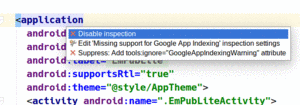
Figure 55: Quick Fixes
As we build EmPubLite, we will need to make a number of changes to our
project’s manifest. In this tutorial, we will take care of a couple of these
changes, to show you how to manipulate the AndroidManifest.xml file. Future
tutorials will make yet more changes.
Android Studio users will also get their first chance to work with the
build.gradle file.
This is a continuation of the work we did in the previous tutorial.
You can find the results of the previous tutorial and the results of this tutorial in the book’s GitHub repository.
In these tutorials, you will see references to relative paths, like AndroidManifest.xml,
res/layout/, and so on.
Android Studio users should interpret these paths as being relative to the app/src/main/
directory within the project, except as otherwise noted. So, for example, Step #1 below
will ask you to open AndroidManifest.xml — that file can be found in
app/src/main/AndroidManifest.xml from the project root.
Our application will restrict its supported screen sizes. Tablets make for ideal ebook readers. Phones can also be used, but the smaller the phone, the more difficult it will be to come up with a UI that will let the user do everything that is needed, yet still have room for more than a sentence or two of the book at a time.
We will get into screen size strategies and their details
later in this book.
For the moment, though, we will add a <supports-screens> element to keep our
application off “small” screen devices (under 3” diagonal size).
Android Studio users can double-click on AndroidManifest.xml in the project
explorer.
As a child of the root <manifest> element, add a <supports-screens> element as follows:
<supports-screens
android:largeScreens="true"
android:normalScreens="true"
android:smallScreens="false"
android:xlargeScreens="true"/>
If you look at the <application> element, you will see that it
has a few attributes, including android:allowBackup="true".
This attribute indicates that EmPubLite should participate in
Android’s automatic backup system.
That is not a good idea, until you understand the technical and legal ramifications of that choice, which we will explore much later in this book.
In the short term, change android:allowBackup to be false.
Even after that change, the application element name may have a
beige background. If you hover your mouse over it and look at the
explanatory tooltip, you will see
that it is complaining that this app is not indexable, and that you
should add an ACTION_VIEW activity to the app.
This is ridiculous.
First, this app (hopefully) will never wind up on the Play Store, and so Google’s “app indexing” capability will never be relevant.
Second, developers should not be adding random activities to their app, just based off of some tooltip.
Put your text cursor somewhere inside the application element name
and press Alt-Enter (or the equivalent on macOS).
This should bring up a popup window showing
some “quick fixes” for the problem:

Figure 55: Quick Fixes
Choose the “suppress Lint” option. Then, press Ctrl-Alt-L (or the equivalent on macOS) to reformat the file. You will wind up with something like:
<?xml version="1.0" encoding="utf-8"?>
<manifest package="com.commonsware.empublite"
xmlns:android="http://schemas.android.com/apk/res/android"
xmlns:tools="http://schemas.android.com/tools">
<supports-screens
android:largeScreens="true"
android:normalScreens="true"
android:smallScreens="false"
android:xlargeScreens="true" />
<application
android:allowBackup="false"
android:icon="@mipmap/ic_launcher"
android:label="@string/app_name"
android:supportsRtl="true"
android:theme="@style/AppTheme"
tools:ignore="GoogleAppIndexingWarning">
<activity android:name=".EmPubLiteActivity">
<intent-filter>
<action android:name="android.intent.action.MAIN" />
<category android:name="android.intent.category.LAUNCHER" />
</intent-filter>
</activity>
</application>
</manifest>
The <application> element now has a
tools:ignore="GoogleAppIndexingWarning" attribute, and the root
<manifest> element defines the tools XML namespace. The net effect
is that we are telling the build tools — specifically the Lint utility –
that it should ignore this particular issue.
… we will make some changes to the resources of our tutorial project